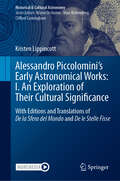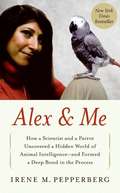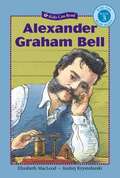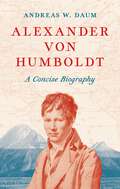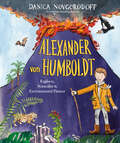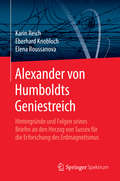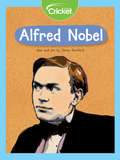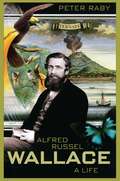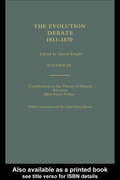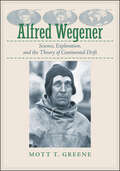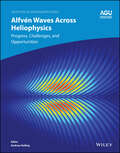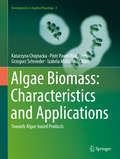- Table View
- List View
Aldous Huxley's Hands: His Quest for Perception and the Origin and Return of Psychedelic Science
by Allene SymonsPsychedelics, neuroscience, and historical biography come together when a journalist finds a lost photograph of Aldous Huxley and uncovers a hidden side of the celebrated author of Brave New World and The Doors of Perception. Allene Symons had no inkling that Aldous Huxley was once a friend of her father's until the summer of 2001 when she discovered a box of her dad's old photographs. For years in the 1940s and '50s, her father had meticulously photographed human hands in the hope of developing a science of predicting human aptitudes and even mental illness. In the box, along with all the other hand images, was one with the name of Aldous Huxley on the back. How was it possible for two such unlikely people to cross paths--her aircraft-engineer father and the famous author? This question sparked a journalist's quest to understand what clearly seemed to be a little-known interest of Aldous Huxley. Through interviews, road trips, and family documents, the author reconstructs a time peaking in mid-1950s Los Angeles when Huxley experimented with psychedelic substances, ran afoul of gatekeepers, and advocated responsible use of such hallucinogens to treat mental illness as well as to achieve states of mind called mystical. Because the author's father had studied hundreds of hands, including those of schizophrenics, he was invited into Huxley's research and discussion circle. This intriguing narrative about the early psychedelic era throws new light on one of the 20th-century's foremost intellectuals, showing that his experiments in consciousness presaged pivotal scientific research underway today.
Alessandro Piccolomini’s Early Astronomical Works: II. An Examination of Their Scientific Content (Historical & Cultural Astronomy)
by Elly DekkerThis book presents the first detailed scientific examination of Alessandro Piccolomini’s two early astronomical works – De la Sfera del Mondo and De le Stelle Fisse. First published in Venice in 1540, the two treatises are amongst the earliest scientific texts written in the vernacular (Italian) and were specifically composed to make astronomical principles and practices available to a lay reader. Whereas De la Sfera del Mondo is essentially an updated adaptation of the theoretical astronomical material contained in Sacrobosco’s De Sphaera, this book examines his views on a number of key topics – such as precession, the motion of the solar apogee and the size and distance of the planets from Earth. The author also presents a radical reassessment of De le Stelle Fisse, focusing on the innovative methods Piccolomini employed to create a viewer-centric approach for identifying the stars. As such, Piccolomini’s guide to the heavens should be seen as a distant forerunner of the successful genre of elementary handbooks that were developed in the late 18th century, and which remain popular with amateur stargazers even in the 21st century. The book also addresses how Piccolomini’s treatises were used by contemporary astronomers by examining the manuscript notes that were left in various surviving copies of his books. It provides a convincing explanation of the unique directional notation on his stellar maps and assesses the relative accuracy of his stellar co-ordinates against contemporary and modern ephemerides and pictorial sources. It also argues that Piccolomini probably designed his distinctive series of maps of the constellations and the related Tables by using a celestial globe to compile his astronomical data. Finally, the author examines the series of refinements and corrections in the successive editions of Piccolomini’s two treatises, thereby showing the extent to which his two early astronomical treatises remained an on-going enterprise for over 60 years. This book is a companion volume to Alessandro Piccolomini’s Early Astronomical Works: I. An Exploration of Their Cultural Significance by Kristen Lippincott in the same series.
Alessandro Piccolomini’s Early Astronomical Works: With Editions and Translations of De la Sfera del Mondo and De le Stelle Fisse (Historical & Cultural Astronomy)
by Kristen LippincottThis book presents the first interdisciplinary study of Alessandro Piccolomini’s two early astronomical works – De la Sfera del Mondo and De le Stelle Fisse. First published in Venice in 1540, the two treatises are amongst the earliest scientific texts written in the vernacular (Italian) and were specifically composed to make astronomical principles and practices available to a lay reader. The book includes modern editions of the original Italian texts and an English translation of both treatises (all appended as Electronic Supplementary Material to the online edition), while also examining the contents of each treatise in depth. It explores the way in which Piccolomini addresses the theoretical underpinnings of the science of astronomy in his De la Sfera del Mondo by providing a version of Sacrobosco’s De sphaera, which he has expanded and updated to include the views of more recent natural philosophers and astronomers. The book also presents an extended study ofDe le Stelle Fisse and the unique method that Piccolomini devised for observing the stars, as well as explanatory notes on the sources behind his explanations of the mythographic sources of each constellation.In addition to this, the book presents a detailed examination of the cultural context in which Piccolomini wrote his treatises, focussing on such issues as how astronomy was taught in Italian universities in the 16th-century; the on-going debates on the viability of Italian as language as a means for discussing scientific ideas; and how Piccolomini navigated through the competitive and complicated world of book production in 16th-century Venice. Given that Piccolomini originally dedicated both treatises to his female friend, the Sienese aristocrat Laudomia Forteguerri, there is also a discussion of the mysteries behind their personal relationship; of the dynamics of Sienese society at the time; and, in particular, the role that the Sienese Accademia degli Intronati played in Piccolomini’s own intellectual development and the composition of his astronomical treatises.This book is a companion volume to Alessandro Piccolomini’s Early Astronomical Works: II. An Examination of Their Scientific Content by Elly Dekker in the same series.
Alex and Me: How a Scientist and a Parrot Discovered a Hidden World of Animal Intelligence— and Formed a Deep Bond in the Process
by Roger Lewin Irene PepperbergOn September 6, 2007, an African Grey parrot named Alex died prematurely at age thirty-one. His last words to his owner, Irene Pepperberg, were 'You be good. I love you'. What would normally be a quiet, very private event was, in Alex's case, headline news. Over the thirty years they had worked together, Alex and Irene had become famous - two pioneers who opened an unprecedented window into the hidden yet vast world of animal minds. Alex's brain was the size of a shelled walnut, and when Irene and Alex first met, birds were not believed to possess any potential for language, consciousness, or anything remotely comparable to human intelligence. Yet, over the years, Alex proved many things. He could add. He could sound out words. He understood concepts like bigger, smaller, more, fewer, and none. He was capable of thought and intention. Together, Alex and Irene uncovered a startling reality: We live in a world populated by thinking, conscious creatures. The fame that resulted was extraordinary. Yet there was a side to their relationship that never made the papers. They were emotionally connected to one another. They shared a deep bond far beyond science. Alex missed Irene when she was away. He was jealous when she paid attention to other parrots, or even people. He liked to show her who was boss. He loved to dance. He sometimes became bored by the repetition of his tests, and played jokes on her. Sometimes they sniped at each other. Yet nearly every day, they each said, 'I love you'. Alex and Irene stayed together through thick and thin - despite sneers from experts, extraordinary financial sacrifices, and a nomadic existence from one university to another. The story of their thirty-year adventure is equally a landmark of scientific achievement and of an unforgettable human-animal bond.
Alex the Parrot: A True Story
by Stephanie SpinnerIn 1977, graduate student Irene Pepperberg walked into a pet store and bought a year-old African grey parrot. Because she was going to study him, she decided to call him Alex--short for Avian Learning EXperiment. At that time, most scientists thought that the bigger the brain, the smarter the creature; they studied great apes and dolphins. African greys, with their walnut-sized "birdbrains," were pretty much ignored--until Alex. His intelligence surprised everyone, including Irene. He learned to count, add, and subtract; to recognize shapes, sizes, and colors; and to speak, and understand, hundreds of words. These were things no other animal could do. Alex wasn't supposed to have the brainpower to do them, either. But he did them anyway.Accompanied by Meilo So's stunning illustrations, Alex and Irene's story is one of groundbreaking discoveries about animal intelligence, hard work, and the loving bonds of a unique friendship.
Alexander Graham Bell
by Elizabeth MacleodMeet Alexander Graham Bell -- pioneering educator and inventor of the telephone. The story of Bell's world-changing invention and his struggle to perfect it is told in level-appropriate language.
Alexander Graham Bell
by Ilanthai S. RamasamyThis narrates the biography of Alexander Graham Bell, an eminent scientist, inventor, engineer and innovator who invented the first practical telephone.
Alexander Graham Bell and the Telephone (Cornerstones of Freedom, 2nd series)
by Christine WebsterThe story of Alexander Graham Bell--his childhood, his interests, his family and how he invented telephone.
Alexander Graham Bell for Kids: His Life and Inventions, with 21 Activities (For Kids series #70)
by Mary Kay CarsonWinner of the 2019 AAAS/Subaru SB&F Prize for Excellence in Science Book Alexander Graham Bell invented not only the telephone, but also early versions of the phonograph, the metal detector, airplanes, and hydrofoil boats. This Scottish immigrant was also a pioneering speech teacher and a champion of educating those with hearing impairments, work he felt was his most important contribution to society. Bell worked with famous Americans such as Helen Keller and aviators Glenn Curtiss and Samuel P. Langley, and his inventions competed directly with those of Thomas Edison and the Wright Brothers. This unique biography includes a time line, a list of online resources, and 21 engaging hands-on activities to better appreciate Bell's remarkable accomplishments. Kids will: Construct a Pie Tin Telegraph and a Pizza Box Phonograph "See" and "feel" sound by building simple devices Communicate using American Sign Language Send secret messages using Morse code Investigate the properties of ailerons on a paper airplane Build and fly a tetrahedral kite And more!
Alexander L. George: With a Foreword by Dan Caldwell (Pioneers in Arts, Humanities, Science, Engineering, Practice #15)
by Dan CaldwellAlexander L. George was one of the most productive and respected political scientistsof the late twentieth century. He and his wife, Juliette George, wrote one of the firstpsychobiographies, and Professor George went on to write seminal articles and booksfocusing on political psychology, the operational code, foreign policy decisionmaking,case study methodology, deterrence, coercive diplomacy, policy legitimacy, and bridgingthe gap between the academic and policymaking communities. This book is the firstand only one to contain examples of the works across these fields written by AlexanderGeorge and several of his collaborators.• This is a collection of Alexander L. George's works from the major fields to whichhe contributed.• There are biographical essays by his wife and co-author (Juliette L. George), daughter(Mary George Douglass), former student (Dan Caldwell), and professional colleague(Janice Gross Stein).• There are 25 photographs of Alexander L. George and his family which have notpreviously been published.
Alexander Wilson: The Scot Who Founded American Ornithology
by Edward H. Burtt William E. Davis Jr.Audubon was not the father of American ornithology. That honorific belongs to Alexander Wilson, whose encyclopedic American Ornithology established a distinctive approach that emphasized the observation of live birds. In the first full-length study to reproduce all of Wilson's unpublished drawings for the nine-volume Ornithology, Edward Burtt and William Davis illustrate Wilson's pioneering and, today, underappreciated achievement as the first ornithologist to describe the birds of the North American wilderness. Abandoning early ambitions to become a poet in the mold of his countryman Robert Burns, Wilson emigrated from Scotland to settle near Philadelphia, where the botanist William Bartram encouraged his proclivity for art and natural history. Wilson traveled 12,000 miles on foot, on horseback, in a rowboat, and by stage and ship, establishing a network of observers along the way. He wrote hundreds of accounts of indigenous birds, discovered many new species, and sketched the behavior and ecology of each species he encountered. Drawing on their expertise in both science and art, Burtt and Davis show how Wilson defied eighteenth-century conventions of biological illustration by striving for realistic depiction of birds in their native habitats. He drew them in poses meant to facilitate identification, making his work the model for modern field guides and an inspiration for Audubon, Spencer Fullerton Baird, and other naturalists who followed. On the bicentennial of his death, this beautifully illustrated volume is a fitting tribute to Alexander Wilson and his unique contributions to ornithology, ecology, and the study of animal behavior.
Alexander von Humboldt: A Concise Biography
by Andreas W. DaumAn engaging account of the life and work of the legendary polymath Alexander von HumboldtIn this lucid biography, Andreas Daum offers a succinct and novel interpretation of the life and oeuvre of Alexander von Humboldt (1769―1859). A Prussian nobleman born into the age of European Enlightenment, Humboldt was a contemporary of Napoleon, Simón Bolívar, and Charles Darwin. As a naturalist and scholar, he traveled the world, from the Americas to Central Asia, and recorded his observations in multiple volumes. Humboldt is still admired today for his interdisciplinary outreach and ecological awareness.Moving beyond the conventional views of Humboldt as either intellectual superhero or gentleman colonizer, Daum&’s incisive account focuses on Humboldt in the context of the tumultuous period of history in which he lived. Humboldt embodied the contradictions that marked the age of Atlantic Revolutions. He became a critic of slavery and embraced the emerging civil society but remained close to authoritarian rulers. He dedicated his life to scientific research yet was driven by emotional impulses and pleaded for an aesthetic appreciation of nature. Daum introduces a man passionately striving to establish a &“cosmic&” understanding of nature while grappling with the era&’s explosion of knowledge.This book provides the first concise biography of Humboldt, covering all periods of his life, exploring his personality, the vast range of his works, and his intellectual networks. Daum helps us understand Humboldt as a seminal historical figure and illuminates the role of science at the dawn of the global world.
Alexander von Humboldt: Explorer, Naturalist & Environmental Pioneer
by Danica NovgorodoffBudding botanists, growing geologists, and early explorers will dive into this picture book biography about the father of ecology, Alexander von Humboldt. The captivating prose and art from a New York Times bestselling illustrator will spark a passion for discovery and conservation in the youngest readers.Whether sailing across the ocean, hiking through the jungle, or climbing the highest volcanic peaks, everywhere Alexander went, he observed the land, animals, and culture. And where others saw differences, Alexander spotted connections. Discover the incredible life of naturalist Alexander von Humboldt, whose explorations created the basis for modern ecology, whose travels made him one of the most famous scientists of his day, and whose curiosities have inspired generations of creative thinkers.
Alexander von Humboldts Geniestreich: Hintergründe und Folgen seines Briefes an den Herzog von Sussex für die Erforschung des Erdmagnetismus
by Karin Reich Eberhard Knobloch Elena RoussanovaDer Brief, den Alexander von Humboldt am 23. April 1836 an Augustus Frederick, den Herzog von Sussex - damals Präsident der Royal Society of London - richtete, ist wahrscheinlich der wichtigste und der folgenreichste Brief, den der berühmte deutsche Forschungsreisende in seinem Leben verfasst hat. Dieser These gehen die Autoren der vorliegenden Studie nach, zumal die Quellen, Hintergründe und Folgen dieses epochemachenden Briefes bislang nicht im Detail untersucht waren. Humboldt ging es vor allem um den Ausbau und die Erweiterung der erdmagnetischen Forschungen im britischen Empire, was die globale Erforschung dieses rätselhaften Naturphänomens fördern sollte. Er hat sein Schreiben genau zum richtigen Zeitpunkt verfasst: Der Brief löste eine Lawine von Forschungsaktivitäten aus. Von Humboldts Initiative profitierte nicht allein Großbritannien, sondern auch Russland, die USA und - was bislang kaum wahrgenommen bzw. herausgestellt wurde - Göttingen, das zum Zentrum der erdmagnetischen Forschungen weltweit avancierte. Die Studie zeigt deutlich, dass Humboldts Brief nur deshalb so überaus erfolgreich sein konnte, weil er sich auf die von Carl Friedrich Gauß und Wilhelm Weber in Göttingen erzielten Forschungen zu stützen vermochte: So war Humboldts Erfolg auch ein Verdienst von Gauß und Weber. Der Brief Humboldts wird in der vorliegenden Monographie erstmals nach der Originalvorlage ediert und auch in deutscher Übersetzung vorgestellt. Ferner werden weitere relevante Dokumente sowohl in Originalsprache als auch in deutscher Übersetzung veröffentlicht. Die Darstellung wird von informativem, historischem Bildmaterial ergänzt. Der Band wendet sich an ein Fach- wie auch an ein wissenschaftshistorisch interessiertes Publikum.
Alfred Nobel
by James RumfordDid you know the Nobel Prize is named after the man who invented dynamite? Learn all about the life of Alfred Nobel, who grew up in a desperately poor family.
Alfred Nobel: The Man Behind the Peace Prize
by Kathy-Jo WarginAlfred Nobel was the man who founded what became known as The Nobel Prizes. Nobel also invented dynamite, becoming very wealthy from his invention. Saddened by its use for harmful destruction, Nobel left his fortune to create yearly prizes for those who have rendered the greatest services to mankind.
Alfred Russel Wallace: A Life
by Peter RabyIn 1858, Alfred Russel Wallace, aged thirty-five, weak with malaria, isolated in the Spice Islands, wrote to Charles Darwin: he had, he said excitedly, worked out a theory of natural selection. Darwin was aghast--his work of decades was about to be scooped. Within two weeks, his outline and Wallace's paper were presented jointly in London. A year later, with Wallace still on the opposite side of the globe, Darwin published On the Origin of Species. This new biography of Wallace traces the development of one of the most remarkable scientific travelers, naturalists, and thinkers of the nineteenth century. With vigor and sensitivity, Peter Raby reveals his subject as a courageous, unconventional explorer and a man of exceptional humanity. He draws more extensively on Wallace's correspondence than has any previous biographer and offers a revealing yet balanced account of the relationship between Wallace and Darwin. Wallace lacked Darwin's advantages. A largely self-educated native of Wales, he spent four years in the Amazon in his mid-twenties collecting specimens for museums and wealthy patrons, only to lose his finds in a shipboard fire in the mid-Atlantic. He vowed never to travel again. Yet two years later he was off to the East Indies on a vast eight-year trek; here he discovered countless species and identified the point of divide between Asian and Australian fauna, 'Wallace's Line.' After his return, he plunged into numerous controversies and published regularly until his death at the age of ninety, in 1913. He penned a classic volume on his travels, founded the discipline of biogeography, promoted natural selection, and produced a distinctive account of mind and consciousness in man. Sensitive and self-effacing, he was an ardent socialist--and spiritualist. Wallace is one of the neglected giants of the history of science and ideas. This stirring biography--the first for many years--puts him back at center stage, where he belongs.
Alfred Russell Wallace Contributions to the theory of Natural Selection, 1870, and Charles Darwin and Alfred Wallace , 'On the Tendency of Species to form Varieties' (The\evolution Debate, 1813-1870 Ser.)
by Charles Darwin Alfred Russel Wallace David KnightWallace noticed on expeditions to the Amazon and the Malay archipelego that mammals in Southeast Asia are more advanced than their Australian cousins. His suggestion was that the two continents had split before the better adapted mammals had evolved in Asia. The isolated Australian marsupials were able to thrive, whilst those in Asia were driven to extinction by competition from more advanced mammals. This led to his theory of natural selection, which he presented to the Linnean Society in 1858 with Charles Darwin. This volume reprints those papers presented to the Linnean Society.
Alfred Wegener: Science, Exploration, and the Theory of Continental Drift
by Mott T. GreeneA masterful biography of Alfred Wegener (1880–1930), the German scientist who discovered continental drift.Winner of the CHOICE Outstanding Academic Title of the Choice ACRLAlfred Wegener aimed to create a revolution in science which would rank with those of Nicolaus Copernicus and Charles Darwin. After completing his doctoral studies in astronomy at the University of Berlin, Wegener found himself drawn not to observatory science but to rugged fieldwork, which allowed him to cross into a variety of disciplines. The author of the theory of continental drift—the direct ancestor of the modern theory of plate tectonics and one of the key scientific concepts of the past century—Wegener also made major contributions to geology, geophysics, astronomy, geodesy, atmospheric physics, meteorology, and glaciology. Remarkably, he completed this pathbreaking work while grappling variously with financial difficulty, war, economic depression, scientific isolation, illness, and injury. He ultimately died of overexertion on a journey to probe the Greenland icecap and calculate its rate of drift. This landmark biography—the only complete account of the scientist’s fascinating life and work—is the culmination of more than twenty years of intensive research. In Alfred Wegener, Mott T. Greene places Wegener’s upbringing and theoretical advances in earth science in the context of his brilliantly eclectic career, bringing Wegener to life by analyzing his published scientific work, delving into all of his surviving letters and journals, and tracing both his passionate commitment to science and his thrilling experiences as a polar explorer, a military officer during World War I, and a world-record–setting balloonist. In the course of writing this book, Greene traveled to every place that Alfred Wegener lived and worked—to Berlin, rural Brandenburg, Marburg, Hamburg, and Heidelberg in Germany; to Innsbruck and Graz in Austria; and onto the Greenland icecap. He also pored over archives in Copenhagen, Munich, Marburg, Graz, and Bremerhaven, where the majority of Wegener’s surviving papers are found. Written with great immediacy and descriptive power, Alfred Wegener is a powerful portrait of the scientist who pioneered the modern concept of unified Earth science. The book should be of interest not only to earth scientists, students of polar travel and exploration, and historians but to all readers who are fascinated by the great minds of science.
Alfvén Waves Across Heliophysics: Progress, Challenges, and Opportunities (Geophysical Monograph Series)
by Andreas KeilingAlfvén Waves Across Heliophysics Progress, Challenges, and Opportunities Alfvén waves are fundamental to the dynamics of space plasmas. Recent advances in our knowledge about Alfvén waves have come from several directions, including new space missions to unexplored heliospheric regions, sophisticated rocket campaigns in the auroral zone, enlarged magnetometer arrays and radar networks, and significant advances in computer modeling. Alfvén Waves Across Heliophysics: Progress, Challenges, and Opportunities is an interdisciplinary collaboration from different space science communities to review recent and current Alfvén wave research. Volume highlights include: Alfvén waves in the solar atmosphereAlfvén waves at the giant planetsAlfvén waves at MarsAlfvén waves in moon-magnetosphere systemsAlfvén waves in geospaceAlfvén waves in the laboratory The American Geophysical Union promotes discovery in Earth and space science for the benefit of humanity. Its publications disseminate scientific knowledge and provide resources for researchers, students, and professionals.
Algae Biomass: Towards Algae-based Products (Developments in Applied Phycology #8)
by Katarzyna Chojnacka Piotr Pawel Wieczorek Grzegorz Schroeder Izabela MichalakThis book is a compendium of knowledge on the useful properties of algae in the context of application as a useful component of innovative natural products. It presents all aspects of industrial applications of macroalgae biomass derived from the natural environment. Despite many interesting characteristics, algae are still regarded as undervalued raw material, therefore, present in the following chapters are not only environmental benefits arising from the development of excessive algal biomass, but also the distribution and biology of algae in natural conditions in reservoirs, methods of obtaining extracts from biomass of algae for industrial purposes. Furthermore, it also includes topics such as the use of biomass and algae extracts for the industrial purposes, in animal breeding and for agricultural purposes, as well as the economic aspects of algae biomass harvesting for industrial purposes. The book is intended for a wide audience interested in new methods of obtaining the biomass from the natural environment for industrial purposes and the manufacture of products based on bioactive substances obtained from the environment.
Algae Biotechnology: Products and Processes (Green Energy and Technology)
by Faizal Bux Yusuf ChistiThis book examines the utilization of algae for the development of useful products and processes with the emphasis towards green technologies and processes, and the requirements to make these viable. Serving as a complete reference guide to the production of biofuels and other value added products from micro and macro algae, it covers various aspects of algal biotechnology from the basics to large scale cultivation, harvesting and processing for a variety of products. It is authored and edited by respected world experts in the field of algal biotechnology and provides the most up to date and cutting edge information on developments in the field. Over the past decade there has been substantial focus and related literature on the application of algal biomass for the generation of novel processes and products. 'Algae Biotechnology: Products and Processes' encompasses a holistic approach to critically evaluating developments in the field of algal biotechnology whilst taking into account recent advances and building on the body of knowledge. Aspects of the effects of harmful algae are also discussed, as well as the potential commercial application of algal biotechnology, the techno-economic feasibility of algal biodiesel production and the use of genetic and metabolic engineering for the improvement of yield. Other bioenergy sources such as alcohol fuels, aviation fuels, biohydrogen and biogas are also covered. This book is intended for postgraduates and researchers working in the biofuels and algal industry; it constitutes ideal reference material for both early stage and established researchers.
Algae Energy: Algae as a New Source of Biodiesel (Green Energy and Technology)
by Muhammet Fatih Demirbas Ayhan DemirbasAlgae Energy covers the production of algae culture and the usage of algal biomass conversion products. It also reviews modern biomass-based transportation fuels, including biodiesel, bio-oil, biomethane and biohydrogen. Each chapter opens with fundamental explanations suitable for those with a general interest in algae energy and goes on to provide in-depth scientific details for more expert readers. Algae energy is discussed within the wider context of green energy, with chapters covering topics such as: green energy facilities, algae technology, energy from algae and biodiesel from algae. Algae Energy addresses the needs of energy researchers, chemical engineers, fuel and environmental engineers, postgraduate and advanced undergraduate students, and others interested in a practical tool for pursuing their interest in bio-energy.
Algae Mediated Bioremediation: Industrial Prospectives, Volumes 1 - 2
by Se-Kwon Kim Gokare A. Ravishankar Ambati Ranga Rao, Se-Kwon KimAlgae Mediated Bioremediation Develop new methods for remediating pollution with this cutting-edge guide In a world where environmental remediation and pollution removal are becoming more critical with every passing day, the search for organic and sustainable solutions has never been more critical. Removing organic pollutants through the use of algae has become an especially promising avenue for bioremediation, with a far lower environmental impact than comparable mechanical, physical, or chemical approaches. The possibility of deriving bioenergy from the resulting biomass makes this approach even more potentially critical to a sustainable future. Algae Mediated Bioremediation offers a cutting-edge overview of these processes and their applications. Its comprehensive approach to the problems of pollution abatement and the value of algae as environmental and biotechnological agents include both practical solutions and key gaps in existing research. Algae Mediated Bioremediation readers will also find: Case studies of successful use drawn from across the globe Detailed discussion of remediating aquatic, atmospheric, and terrestrial habitats Applications for value-added products incorporating biomass Algae Mediated Bioremediation is ideal for biotechnologists, biochemists, natural products chemists, and other researchers working in industry or environmental research.


